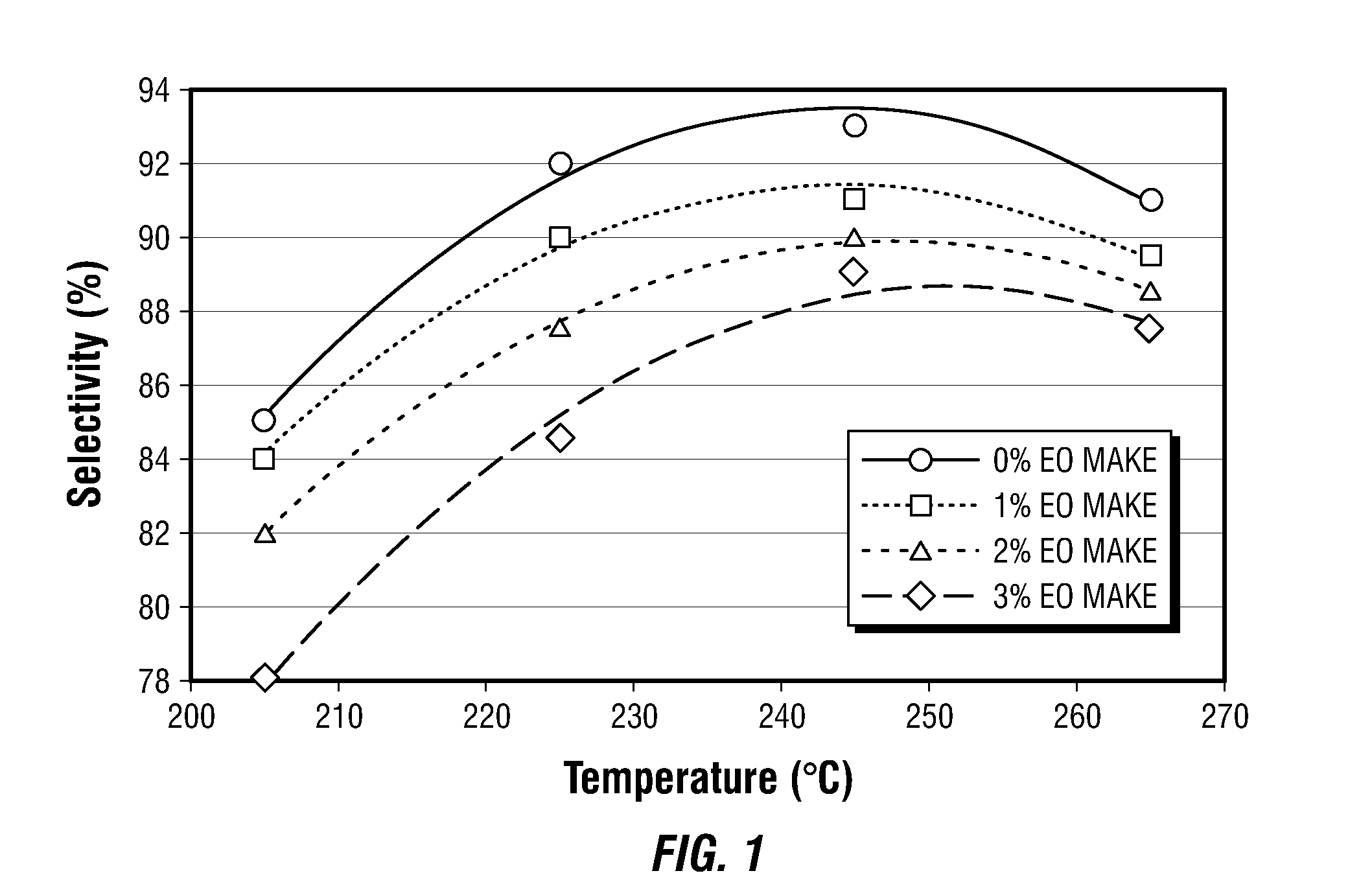Process for improving the selectivity of an eo catalyst
a technology of eo catalyst and selectivity, which is applied in the direction of physical/chemical process catalyst, ether preparation, bulk chemical production, etc., can solve the problem that the maximum selectivity that can be achieved is not necessarily achieved by minimizing the operating temperature, and achieves the effect of increasing ethylene, increasing oxygen, and increasing selectivity
- Summary
- Abstract
- Description
- Claims
- Application Information
AI Technical Summary
Benefits of technology
Problems solved by technology
Method used
Image
Examples
example 1
[0076]Example 1 illustrates the impact of temperature on the selectivity of a high selectivity EO catalyst (Catalyst A) by comparing standard test runs performed in laboratory microreactors. Catalyst A is a high selectivity catalyst having a silver content of about 13 weight percent on an alpha alumina support. Dopants include Re, W, Li and Cs.
[0077]Catalyst was operated at 205° C., 225° C., 245° C. and 265° C. in a feed mixture comprising 30% v ethylene, 8.0% v oxygen, 3.0% v carbon dioxide, small amounts of ethyl chloride moderator and nitrogen ballast. At each temperature the gas hourly space velocity was varied such that the product stream contained either 1.0% v EO, 2.0% v EO or 3.0% v EO. For all data collected, the chloride moderator has been adjusted to achieve maximum or “optimized” selectivity at the target production rate. Data from those sets where then subjected to computerized curve-fitting to allow approximation of selectivities at vanishing small or “0% EO”. All sele...
example 2
[0079]Example 2 illustrates the impact of temperature on the selectivity of a different high selectivity EO catalyst (Catalyst B). Catalyst B is a high selectivity catalyst having a silver content of about 17.5 weight percent on an alpha alumina support. Dopants include Re, W, Li, and Cs. The catalyst was operated at flowrates between 33 and 539 standard cubic centimeters per minute in a feed mixture comprising 30.9% v ethylene, 7.3% v oxygen, 1.6% carbon dioxide, small amounts of ethyl chloride moderator, and nitrogen ballast. The inlet pressure was maintained at 18.1 barg. At each flowrate, the chloride moderator was adjusted to achieve maximal or “optimized” selectivity at the target production rate of 2.48% delta EO. Several flowrates were repeated, and all the selectivity-optimized data are displayed in FIG. 2.
[0080]Upon examination of FIG. 2, it is immediately apparent that as catalyst temperature was progressively reduced from about 260° C. towards 245° C., selectivity improv...
PUM
| Property | Measurement | Unit |
|---|---|---|
| operating temperature T2 | aaaaa | aaaaa |
| operating temperature T2 | aaaaa | aaaaa |
| operating temperature T2 | aaaaa | aaaaa |
Abstract
Description
Claims
Application Information
 Login to View More
Login to View More - R&D
- Intellectual Property
- Life Sciences
- Materials
- Tech Scout
- Unparalleled Data Quality
- Higher Quality Content
- 60% Fewer Hallucinations
Browse by: Latest US Patents, China's latest patents, Technical Efficacy Thesaurus, Application Domain, Technology Topic, Popular Technical Reports.
© 2025 PatSnap. All rights reserved.Legal|Privacy policy|Modern Slavery Act Transparency Statement|Sitemap|About US| Contact US: help@patsnap.com


